Country father (custom)

The solemn national father has been a student custom since the 18th century , in which student hats are pierced with the blade of a sword or bat .
Emergence
As early as the 17th and first half of the 18th centuries, students used to pierce their hats as a symbol of love for a girl. In the following years this custom experienced a change in meaning; piercing the hat now served as a symbolic act accompanying the conclusion of a friendship between two students and the transition to the fraternal you. In a next step, the friendship was transferred to an entire community. The student orders that emerged under the influence of Freemasonry from 1770 created the necessary conditions. According to Conrad, the word “consecration sword” seems to bear witness to this origin, because the sword or sword traditionally play a major role in the Masonic reception ritual. In a third step, during the act, which has now become a ceremony, a cheer was raised on the sovereign (hence the name "sovereign"). This could be the respective prince , but also the emperor . In a text from 1782 it also says:
“ Joseph's sons! / Sound out loud / Our fatherland song! ”Cheers for the emperor were combined with cheers for the fatherland.
With the early country teams it was customary to "stab a country father" in honor of the respective country of origin. Since it was generally customary to equate one's own country team connection with the home region (Prussia, Mark Brandenburg, Westphalia), the country father developed to solemnly affirm the connection between a student and his federal and corps brothers. Today it is seen in many connections as a renewal or refreshment of the boys' envy. Since the father of the country is always stung in pairs, this also expresses a personal friendship between the two involved.
From the late 18th century was sovereign institutionalized particularly in the weapons student corps, while Catholic students' associations, the Cartellverband that Zeremonium as mensur - or duel near rejected rite.
procedure
When Ludwig Wallis (1813) states:
“ Country father is a student song that is sung in honor of the country father. While the singing all those present spear their hats on a bat as a symbol of golden freedom, and swear that they will remain good fellows forever. - This song is particularly characterized by a heartwarming song; The lyrics, too, are beautiful, as in almost all boys' songs. When it is finished, the praesides pull each hat off the bat and cover the heads of the owners with it. A national father is made on every Commersch . "
For the implementation of the country's father, the song Everything is silent, everyone inclines / serious tones is now sung in his ear , which was composed by August Niemann in 1782 using older models. This song contains the initial verse, Landesvater, Schutz und Rater , which has been documented since 1650 and gave the custom its name. In the early 19th century, homage to the country's father was gradually replaced by homage to the fatherland. The form sung today comes from Friedrich Silcher from 1823 and contains various parts of the song with a total of three different melodies for the individual phases of the country father , such as "Piercing the hats", "Pause" and "Retrieving the hats" and "End". The pierced parts of the hats are often (not in the Corps) embroidered in oak leaf or vine leaf shape and given the date of the solemn event.

literature
- Adam Joseph Uhrig: The academic country father, a monument from the age of knights . Wuerzburg 1888.
- Erich Bauer : The original text of the father of stud. August Niemann 1782 . Einst und Jetzt , Vol. 22 (1977), pp. 235-238.
- Joachim Bauer: Student and nation in the mirror of the "Landesvater" song , in: Dieter Langewiesche, Georg Schmidt (ed.): Föderative Nation. Concepts of Germany from the Reformation to the First World War. Munich 2000, pp. 136–155.
- Georg Conrad: The father of the country . In: Student historical contributions (1993), pp. 37–39.
- Wilhelm Fabricius : The German Corps. A historical representation with special consideration of the scaling . Berlin 1898, 2nd edition 1926. pp. 122ff.
- Wilhelm Rehmann: The celebratory country father as the highlight of the Kommerses . Der Convent 6 (1955), pp. 222-227.
- Aribert Schwenke: On the history of the country father . Einst und Jetzt, Vol. 35 (1990), pp. 67-88.
Web links
- Text and melody of "Everything is silent, everyone is tilting"
- The beer stick: 1st, 3rd, 8th & 10th stanza of "Everything is silent, everyone neige" (sung version)
Individual evidence
- ↑ Dieter Langewiesche (ed.). Federative nation. Concepts of Germany from the Reformation to the First World War. Oldenbourg Wissenschaftsverlag GmbH: Munich, 2000. p. 136.
- ^ Meyers Großes Konversations-Lexikon, Volume 12. Leipzig 1908, p. 103
- ↑ Academia 3/2012, p. 44 f.
- ^ Ludwig Wallis: The Göttingen student . Reprint of the 1813 edition, p. 105 f., Online version
- ↑ Joachim Bauer: Student and nation in the mirror of the "Landesvater" song , in: Dieter Langewiesche, Georg Schmidt (ed.): Föderative Nation. Concepts of Germany from the Reformation to the First World War. Munich 2000, pp. 136–155, here: p. 146.

